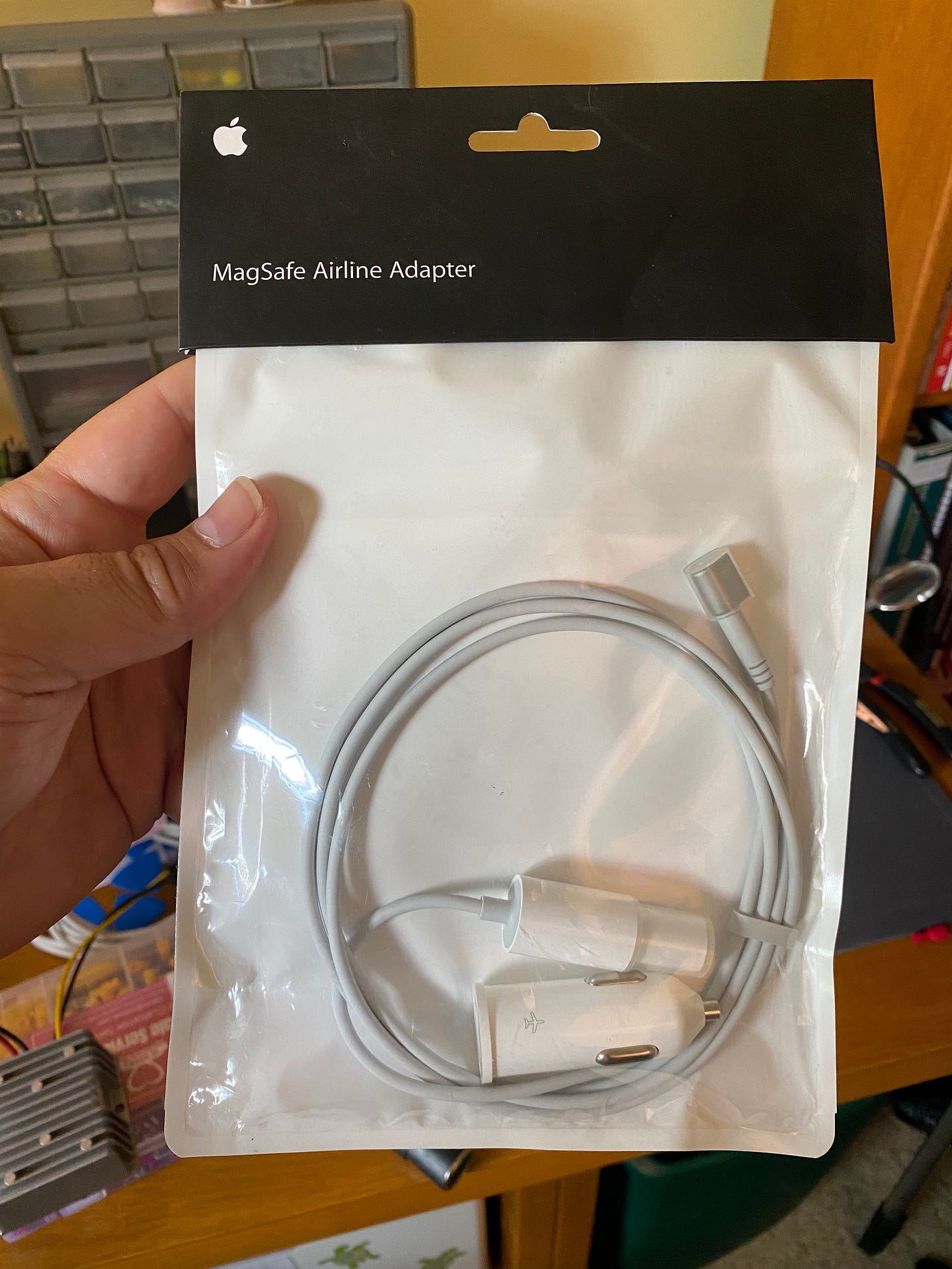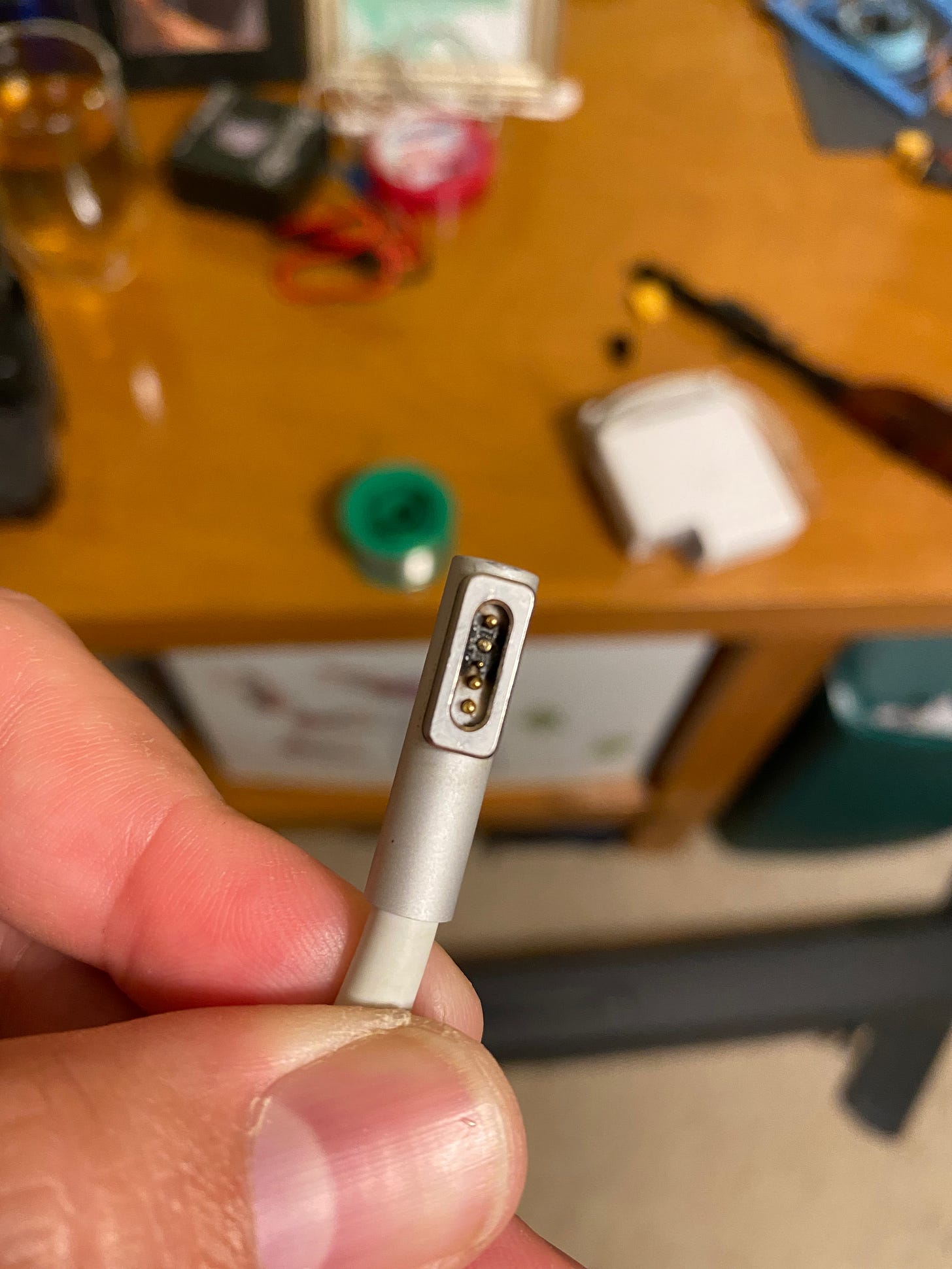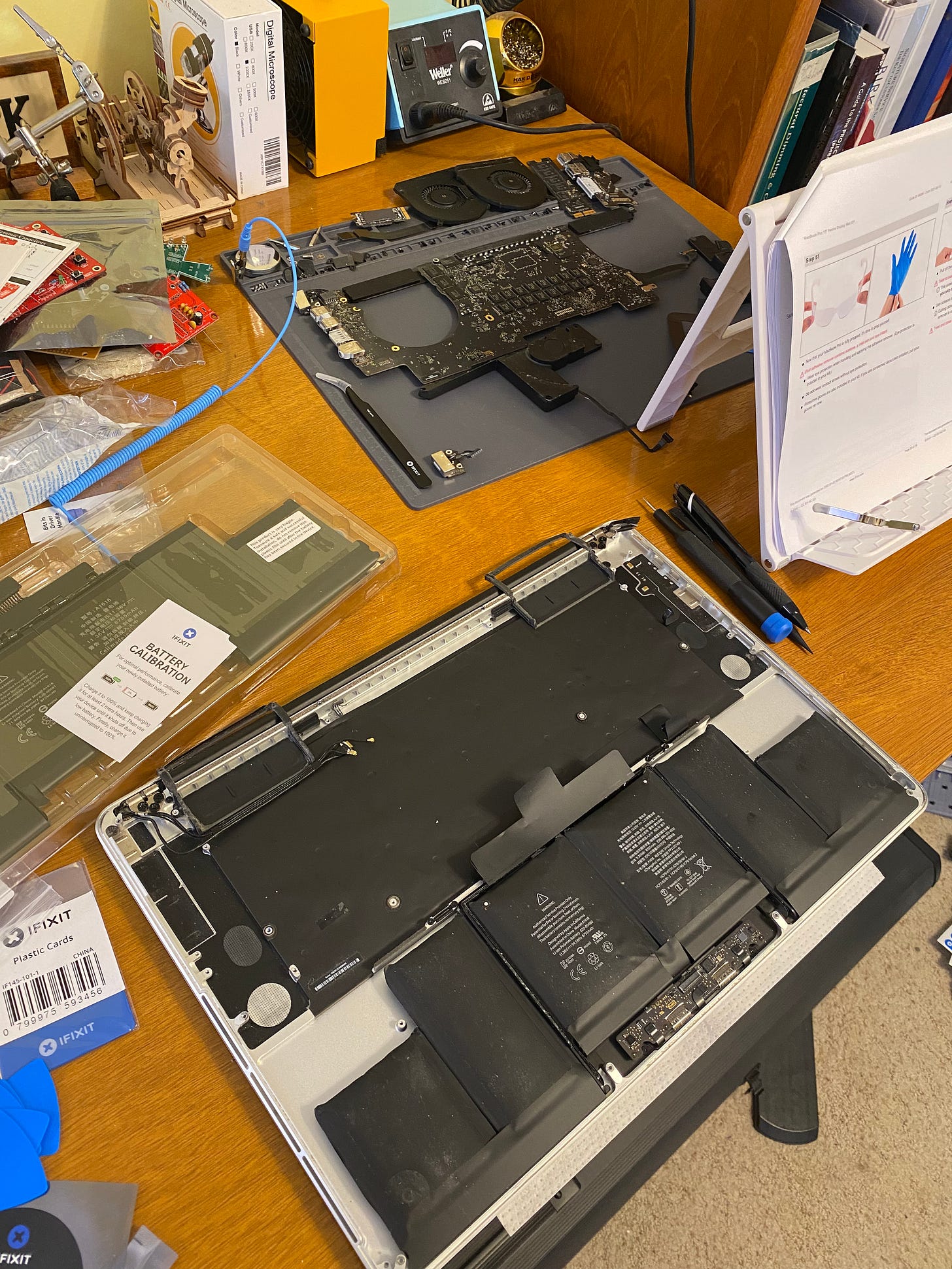In Part 1 of this series, I talked about building my own energy storage system. This week I’m telling you about what happened next - for better and for worse.
This is the Empire Strikes Back portion of this trilogy - it’s moodier and some stuff gets broken - but I promise things will get happier in part 3.
Battery Interchangeability
I love batteries. They felt so expensive and rare when I was a kid, and now it feels like such a luxury just to have a drawer full of AAs, AAAs, and watch batteries.
I enjoy trying to figure out how to make Battery A work for Device B, or how to use a battery to power something that has no business being battery powered, or how to build an AC adapter for a nominally battery-powered device. For example, I might use a sabot to use a AA battery for a device that expects a D battery[1], or might even cut open a 9V battery to get six AAAA batteries and use these batteries to make an AAA-powered device weigh less. These swaps all work because most consumer alkaline batteries provide the same electric potential of 1.5 Volts.
Similarly, because USB ports offer a standard voltage and minimum power output, one can use a laptop or portable USB phone charger to power all sorts of 5 Volt devices - for example, using this cable so that I can power this network switch from my laptop if I want to build a small wired network on-the-go. This standard 5V platform has lead to the emergence of all sorts of ridiculous USB-powered devices.
You can even get a 5V to 12V converter, connect that to a car power inverter, and use that to power a Hue light bulb from a USB battery pack in case you ever need to help with your daughter’s “Planet Party”:
My family has a collection of Ryobi ONE+ tools and 18V Battery Packs, and I began to wonder if I could adapt these to work with my electric bike or as a portable power source. (More on that in a future issue). Could I find a way to utilize these as a more-portable power option?
The Challenge
My time is scarce these days. I get up a couple hours earlier than I’d like so that I have time to run and meditate. Hopefully, I also get 30 minutes for miscellaneous exploration and personal development time. But sometimes it’s hard to focus on something big when it might take weeks or more to wrap it up; other times, it’s just hard to feel motivated. So when a spark of passion comes, I often feel like I just need to carpe the diem. One of those moments came this spring when I learned that Apple was selling a USB-C to MagSafe cable for their newest MacBook model.
I previously talked about how I built a home energy reservoir. This works great for charging phones and USB-C laptops, but to charge a pre-USB-C MacBook I needed to connect the laptop power supply to an AC power inverter. I didn’t like how wasteful or complicated this was. And after all - I have a few MagSafe to USB-C Adapters that I can use to charge newer laptops from old power supplies. I finally had found a way to go in the other direction.
Well, I thought I had. It’s only compatible with newer laptops. But now I was even more preoccupied with solving this problem.
Attempt Number Two
I investigated whether Apple ever made a car adapter for the MacBook. (They haven’t.) But I did learn about the MagSafe Airline Adapter, which is designed to connect to an EmPower outlet on an airplane or a “20mm port” with an adapter. But that “20mm plug” looks an awful lot like a plug for a 21mm car cigarette lighter receptacle. People say it officially doesn't work…but people say all sorts of things. Maybe it would?
I ordered one on eBay for $10. It didn’t work.
Attempt Number Three: Oops
I started exploring whether there was a way to adapt the MagSafe Car Charger to work off a 12V supply. I first found this article, and then finally found an awesome analysis of how to convert a MagSafe charger to work off 12V:
Now that I have a solar-powered 12V battery, how can I charge my laptop from it? An inverter would seem absurdly inefficient, converting from 12V DC to 110V AC just so I can connect my Apple charger and convert back to DC. It would work, but surely there’s some way to skip the cumbersome inverter and charge a MacBook Pro directly from DC?
…
The moment of truth. Would my expensive computer burst into flames when I connected this jury-rigged DC MagSafe charger? I held my breath, plugged in the cable, and… success! Of course it worked. The orange/green indicator LED on the MagSafe 2 connector worked too.
…
This charging method is about 95% efficient, according to the claimed efficiency rating of the boost regulator. I can also leave the regulator permanently connected, since its no-load current is less than 20 mA. In comparison, charging with an inverter and an AC wall charger is about 77% efficient (85% for the inverter times 90% for the wall charger).
It was as though this author had read my mind. I immediately started working to replicate what he did: I grabbed an extra MagSafe 2 charger, cut the cord in half, and soldered an XT60 connector on the Magsafe side.
I’m not used to working with XT60s connectors. There was a decent chance I’d reversed my wires accidentally or damaged the MagSafe cable, so I grabbed my multimeter to check whether the voltage on each pin was correct.
Mistake #1: My multimeter probe bridged the gap between the power pin and ground. I accidentally arc-welded the probe to the pin[2]. I was able to pull them apart, but there were a lot of scorch marks:
I cleaned the connector and everything seemed okay still, so I decided to test it. I connected it to my nearest MacBook. The light didn’t turn on - so clearly it didn’t work. I plugged the MacBook back in to its normal adapter…and that didn’t light up either. Uh oh.
Mistake #2: I’d turned a small error into a big one.
It’s an unnerving thing to watch a laptop run out of energy for the last time - to know that you have one last chance to archive materials before everything goes dark. It felt eschatological, like a technological memento mori.
I hate breaking things, and I was grouchy about this mistake for days – though I don’t know whether I was more upset that I’d broken the laptop or that I couldn’t possibly justify doing further testing on my 12V MagSafe adapter.
Recovery
Burning out a laptop wasn’t the last compulsive action I took in this project.
That same night, I ordered a replacement MagSafe receptacle. It came in a week or so later:
It took me about 2 hours to disassemble and reassemble the computer, but when I was done…it still didn’t work.
Next, I set up a saved search on eBay. Within a few weeks, I found a replacement Logic Board for less than $100. I ordered it, spent two more hours installing it…
…and this time, everything worked.
Epilogue
A week or two after burning out the laptop, I stumbled on to this magnificent connector on AliExpress:
I got two for less than $15, including shipping. They work great, and I can use them with my existing battery backup, including with my now-repaired MacBook Pro.
Obsessions and Scars
Many years ago my finger brushed against a spinning CPU fan. I jerked my hand back and got a cut from the PC case that left a small but still-visible scar.
I think about that accident often; I use it as an illustration to teach my kids. It’s a tidy parable of the importance of not being reactive. And that’s what I had in mind when I first planned this article two months ago: a litany of shame over my maxima culpas on this project. There are certainly things I wish I’d done differently: not starting a project at the end of a long day, testing more carefully, or even just testing on something older and cheaper. And in hindsight, the efficiency gains probably don’t justify the work, especially since I use these old laptops rarely - and there’s no reason to throw good money after bad.
But also…I really wanted to build it! It was a project informed by rational analysis, but not one fundamentally driven by it. Instead of viewing this all through a lens of shame and waste, perhaps I should focus on trying to understand myself better. There’s a place for obsession and variance from the norm, and if I consistently anchored myself to “what is reasonable”, I never would have built my awesome teleprompter. The fact that something is simple or obvious doesn’t always mean that it isn’t novel or useful.
I wish I hadn’t needed to spend the extra cash to get the computer working again. I wish the adapter I built had worked. But if my initial plan had worked, I never would have thought to second-guess my testing methods, and I absolutely would be telling everyone about this awesome adapter I’d built. What I probably need is a practice of rate-limiting or circuit-breaking: when something goes wrong unexpectedly, “fail fast” and make sure I take some time to reorient and update my priors before moving forward. I’ll be thinking about this; if you have thoughts or opinions, please do share.
Next week I’m going to go on another tangent to talk about some recent Air Conditioner troubleshooting I had to do. If you’d like to hear more about thatgm
or just want to make sure you know as soon as part three of this series comes out, please subscribe!
[1] The price per-joule of the energy in “Kirkland Signature” AA batteries is the same as that of Duracell D cells. The AA batteries hold about a fifth as much energy, but I use D cells very rarely, so I’d rather just keep more AA batteries on hand.
[2] A better approach would have been to test continuity between the pin on the XT60 connector and the pin on the MagSafe connector with the power disconnected.









I love those USB-C to magsafe adapters. I ordered two for the 2019 MBPs that only included USB-C ports since its more difficult to throw computers around in frustration if they are still attached via cables!
Jokes aside I have a story that might make you feel better. When we bought our first house last year we discovered upon moving in that the ice maker in the refrigerator didn't work. Being the kind of person with the hubris of "surely I can figure this out and fix it myself," and also desperately wanting ice for all of my beverages, I took the unit out, checked the water line, opened up the panel and saw a nasty electrical burn on the logic board. For expedience (and at the request of my wife) I called a repair company to come out and replace the unit. Once I told him I had already removed it once he kindly suggested I just order a replacement off of amazon and install it myself, since he was going to charge $500 for something I've already done.
So I order the cheapest unit on Amazon that looked identical to the one I had in my fridge, brand name matched up, size matched up, number of wires matched up - I'll just plug it in and we'll have ice! Of course once the unit arrived I realized there was a problem because the connector on the new unit did not match the connector on the old one. I was really confused because the old plug looked almost exactly like a molex connector, and since I've installed my fair share of computer case fans and IDE drives I assumed such a thing would be universal. I popped open the new unit and found another surprise... the innards looked completely different than the old one, which was a strange maze of thin copper connectors and this new one was (understandably) just a silicon logic board and some wires. At this point a reasonable person probably would have just stopped and tried ordering another part but I was impatient and curious. I mean both connectors had four wires, so surely I could just rewire the old connector onto the new unit.
I was able to roughly trace which wires went to what parts of the logic board on the new machine but there were two I was not sure about... 50/50 it would work I thought. If it didn't I'll just take it out and swap them. So I wire it all up, stick it in the refrigerator and voila! It hums to life and pulls water for making ice. Feeling very proud of myself I go to sleep... only to wake up the next morning with my new kitchen floor literally flooded, water dripping into the basement through every crack around the flooring. I had mixed up the hot wire for the water reservoir cutoff and the unit continued to pull water constantly over night. In the end I did get it working, but that was a very long and tedious day of cleaning up a huge spill.